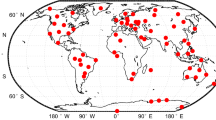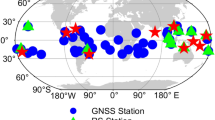Abstract
A global, 2-hourly atmospheric precipitable water (PW) dataset is produced from ground-based GPS measurements of zenith tropospheric delay (ZTD) using the International Global Navigation Satellite Systems (GNSS) Service (IGS) tropospheric products (~80–370 stations, 1997–2006) and US SuomiNet product (169 stations, 2003–2006). The climate applications of the GPS PW dataset are highlighted in this study. Firstly, the GPS PW dataset is used as a reference to validate radiosonde and atmospheric reanalysis data. Three types of systematic errors in global radiosonde PW data are quantified based on comparisons with the GPS PW data, including measurement biases for each of the fourteen radiosonde types along with their characteristics, long-term temporal inhomogeneity and diurnal sampling errors of once and twice daily radiosonde data. The comparisons between the GPS PW data and three reanalysis products, namely the NCEP-NCAR (NNR), ECMWF 40-year (ERA-40) and Japanese reanalyses (JRA), show that the elevation difference between the reanalysis grid box and the GPS station is the primary cause of the PW difference. Secondly, the PW diurnal variations are documented using the 2-hourly GPS PW dataset. The PW diurnal cycle has an annual-mean, peak-to-peak amplitude of 0.66, 0.53 and 1.11 mm for the globe, Northern Hemisphere, and Southern Hemisphere, respectively, with the time of the peak ranging from noon to late evening depending on the season and region. Preliminary analyses suggest that the PW diurnal cycle in Europe is poorly represented in the NNR and JRA products. Several recommendations are made for future improvements of IGS products for climate applications.
Similar content being viewed by others
References
Beutler G, Rothacher M, Schaer S, Springer TA, Kouba J, Neilan RE (1999) The International GPS Service (IGS): an interdisciplinary service in support of earth sciences. Adv Space Res 23: 631–635
Bevis M, Businger S, Herring TA, Rocken C, Anthes R, Ware RH (1992) GPS Meteorology—remote-sensing of atmospheric water-vapor using the global positioning system. J Geophys Res 97(D14): 15787–15801
Byun SH, Bar-Serve Y, Gendt G (2005) The new tropospheric product of the International GNSS Service. In: Proceeding of 2005 ION GNSS Conference, Inst Of Navig, Long Beach
CCSP (2005) Temperature trends in the lower atmosphere: steps for understanding and reconciling differences. Synthesis and assessment product 1.1 of US Climate Change Science Program, available on http://www.climatescience.gov/Library/sap/sap1-1/default.htm
Dai A, Wang J, Ware RH, Van Hove T (2002) Diurnal variation in water vapor over North America and its implications for sampling errors in radiosonde humidity. J Geophys Res 107(D10). doi:10.1029/2001JD000642
Deblonde G, Macpherson S, Mireault Y, Heroux P (2005) Evaluation of GPS precipitable water over Canada and the IGS network. J Appl Meteorol 44: 153–166
Durre I, Vose RS, Wuertz D B (2006) Overview of the Integrated global radiosonde archive. J Climate 16: 53–68
GCOS (2004) Implementation plan for the global observing system for climate in support of the UNFCC. GCOS–92, WMO/TD No. 1219
Hagemann S, Bengtsson L, Gendt G (2003) On the determination of atmospheric water vapor from GPS measurements. J Geophys Res 108(D21). doi:10.1029/2002JD003235
Humphreys TE, Kelley MC, Huber N, Kintner PM Jr (2005) The semidiurnal variation in GPS-derived zenith neutral delay. Geophy Res Lett 32. doi:10.1029/2005GL024207
Morland J, Liniger MA, Kunz H, Balin I, Nyeki S, Matzler C, Kampfer N (2006) Comparison of GPS and ERA40 IWV in the Alpine region, including correction of GPS observations at Jungfraujoch (3584 m). J Geophys Res 111(D04102). doi:10.1029/2005JD006043
Niell AE (1996) Global mapping functions for the atmosphere delay at radio wavelengths. J Geophys Res 101: 3227–3246
Trenberth KE, Fasullo J, Smith L (2005) Trends and variability in column-integrated atmospheric water vapor. Clim Dyn 24: 741–758
Van Cleve DD, Klimowski BA (2007) Addressing the Sippican Mark IIA radiosonde dry bias at the NOAA/NWS Weather Forecast Office in Flagstaff, AZ, presentation at The National Weather Association’s 32nd Annual Meeting, Reno, Nevada, 13–18 October 2007 (Available on http://www.nwas.org/meetings/nwa2007/index.php)
Wang J, Zhang L (2008) Systematic errors in global radiosonde precipitable water data from comparisons with ground-based GPS measurements. J Clim 21: 2218–2238
Wang J, Zhang L, Dai A (2005) Global estimates of water-vapor-weighted mean temperature of the atmosphere for GPS applications. J Geophys Res 110(D21101). doi:10.1029/2005JD006215
Wang J, Zhang L, Dai A (2006) A global, 2-hourly atmospheric precipitable water dataset from IGS ground-based GPS measurements: scientific applications and future needs. In: Proceeding of IGS workshop 2006, 8–11, May 2006, Darmstadt, Germany
Wang J, Zhang L, Dai A, Van Hove T, Van Baelen J (2007) A near-global, 2-hourly data set of atmospheric precipitable water dataset from ground-based GPS measurements. J Geophys Res 112(D11107). doi:10.1029/2006JD007529
Ware RH et al (2000) SuomiNet: A real-time national GPS network for atmospheric research and education. Bull Am Meteorol Soc 81: 677–694
Author information
Authors and Affiliations
Corresponding author
Additional information
The National Center for Atmospheric Research is sponsored by the National Science Foundation.
Rights and permissions
About this article
Cite this article
Wang, J., Zhang, L. Climate applications of a global, 2-hourly atmospheric precipitable water dataset derived from IGS tropospheric products. J Geod 83, 209–217 (2009). https://doi.org/10.1007/s00190-008-0238-5
Received:
Accepted:
Published:
Issue Date:
DOI: https://doi.org/10.1007/s00190-008-0238-5




